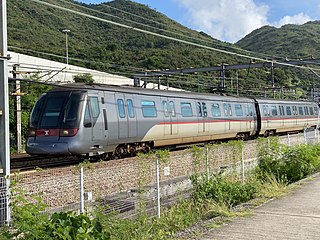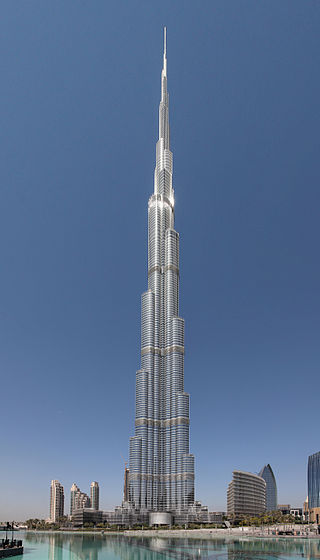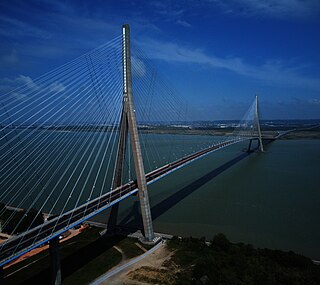
Tsing Ma Bridge is a bridge in Hong Kong. It is the world's 17th-longest span suspension bridge, and was the second longest at the time of its completion. The bridge was named after the two islands it connects, namely Tsing Yi and Ma Wan. It has two decks and carries both road and rail traffic, which also makes it the largest suspension bridge of this type. The bridge has a main span of 1,377 metres (4,518 ft) and a height of 206 metres (676 ft). The span is the longest of all bridges in the world carrying rail traffic.

A cable-stayed bridge has one or more towers, from which cables support the bridge deck. A distinctive feature are the cables or stays, which run directly from the tower to the deck, normally forming a fan-like pattern or a series of parallel lines. This is in contrast to the modern suspension bridge, where the cables supporting the deck are suspended vertically from the main cable, anchored at both ends of the bridge and running between the towers. The cable-stayed bridge is optimal for spans longer than cantilever bridges and shorter than suspension bridges. This is the range within which cantilever bridges would rapidly grow heavier, and suspension bridge cabling would be more costly.

Stonecutters Island or Ngong Shuen Chau is a former island in Victoria Harbour, Hong Kong. Following land reclamation, it is now attached to the Kowloon Peninsula.

The Tung Chung line is one of the ten lines of the MTR system in Hong Kong, linking the town of Tung Chung with central Hong Kong. It was built in the 1990s as part of the Airport Railway project, part of the construction of the new Chek Lap Kok Airport. The line currently travels through eight stations in 31 minutes along its route. The line is coloured orange on the MTR system map.

The Burj Al Arab is a luxury hotel in Dubai, United Arab Emirates. Developed and managed by Jumeirah, it is one of the tallest hotels in the world, although 39% of its total height is made up of non-occupiable space. Burj Al Arab stands on an artificial island that is 280 m (920 ft) from Jumeirah Beach and is connected to the mainland by a private curving bridge. The shape of the structure is designed to resemble the sail of a dhow. It has a helipad near the roof, at a height of 210 m (689 ft) above ground.

Bouygues S.A. is a French engineering group headquartered in the 8th arrondissement of Paris, France. Bouygues is listed on the Euronext Paris exchange and is a blue chip in the CAC 40 stock market index. The company was founded in 1952 by Francis Bouygues and has been led by his son Martin Bouygues since 1989. Martin's older brother, Olivier Bouygues, is a board member.

The Burj Khalifa is a skyscraper in Dubai, United Arab Emirates. It is the world's tallest structure. With a total height of 829.8 m and a roof height of 828 m (2,717 ft), the Burj Khalifa has been the tallest structure and building in the world since its topping out in 2009, surpassing Taipei 101, the holder of that status since 2004.

Prestressed concrete is a form of concrete used in construction. It is substantially "prestressed" (compressed) during production, in a manner that strengthens it against tensile forces which will exist when in service. It was patented by Eugène Freyssinet in 1928.

Ting Kau Bridge is a 1,177-metre (3,862 ft) long cable-stayed bridge in Hong Kong that spans from the northwest of Tsing Yi Island and Tuen Mun Road. It is near the Tsing Ma Bridge which also serves as a major connector between the Hong Kong International Airport on Lantau Island and the rest of Hong Kong. It was completed on 5 May 1998. The bridge is toll-free.

Tsing Yi South Bridge, opened as the Tsing Yi Bridge on 28 February 1974, was the first bridge to Tsing Yi, Hong Kong. It spans the Rambler Channel, linking Tsing Yi Island to the former Pillar Island, Kwai Chung. The bridge spans 610 metres and is 26 metres (85 feet) high. It contributed significantly to the development of Tsing Yi, particularly in the 1970s and 1980s. It is the only bridge across the channel which may be used by cycles and so is the only route connecting Tsing Yi and the Tsuen Wan/Kwai Chung area for cyclists. The name "Tsing Yi South Bridge" was adopted following the 1987 opening of the second bridge to Tsing Yi, the Tsing Yi North Bridge.

The Pont de Normandie is a cable-stayed road bridge that spans the river Seine linking Le Havre to Honfleur in Normandy, northern France. Its total length is 2,143.21 metres (7,032 ft) – 856 metres (2,808 ft) between the two piers. It is also the last bridge to cross the Seine before it empties into the ocean. It is a motorway toll bridge with a footpath and a narrow cycle lane in each direction allowing pedestrians and cyclists to cross the bridge free of charge, while motorcycling is also toll-free.

The Kap Shui Mun Bridge (KSMB) in Hong Kong, part of Lantau Link of Route 8, is one of the longest cable-stayed bridges in the world that transports both road and railway traffic, with the upper deck used for motor vehicles and the lower deck for both vehicles and the MTR. It has a main span of 430 metres (1,410 ft) and an overall length of 750 metres (2,460 ft). It spans the Kap Shui Mun marine channel between Ma Wan and Lantau islands and has a vertical clearance of 47 metres (154 ft) above sea level. The bridge was completed in 1997.

Stonecutters Bridge is a high level cable-stayed bridge spanning the Rambler Channel in Hong Kong, connecting Nam Wan Kok, Tsing Yi to Stonecutters Island. The bridge deck was completed on 7 April 2009, and opened to traffic on 20 December that year. The bridge was the second-longest cable-stayed span in the world at the time of its completion.

The Rambler Channel Bridge is a quadruple-track railway bridge in Hong Kong. It carries the MTR's Airport Express and Tung Chung line over the Rambler Channel, linking Tsing Yi station and Lai King station.

SYSTRA is a multinational engineering and consulting group in the mobility sector, whose fields of activity include rail and public transport. SYSTRA employs about 10,300 people worldwide, and is a limited company which shareholders include French national railway company SNCF, RATP, and various banks.

The Baluarte Bridge, officially the Baluarte Bicentennial Bridge, is a cable-stayed bridge in Mexico. It is located between the municipalities of Concordia in Sinaloa and Pueblo Nuevo in Durango, along the Durango–Mazatlán highway, Mexico 40D. The bridge has a total length of 1,124 m (3,688 ft), with a central cable-stayed span of 520 m (1,710 ft). With the road deck at 403 m (1,322 ft) above the valley below, the Baluarte Bridge is the third-highest cable-stayed bridge in the world, the eighth-highest bridge overall, and the highest bridge in the Americas.
Ian Firth is a British structural engineer and bridge designer.















